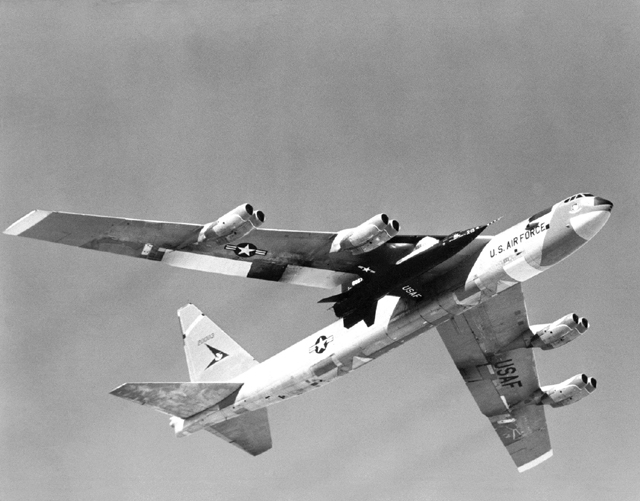Space History Photo: X-15 Mated to B-52 Captive Flight

In this historic photo from the U.S. space agency, one of three X-15 rocket-powered research aircraft is being carried aloft under the wing of its B-52 mothership in January of 1959.
The X-15 was air launched from the B-52 so the rocket plane would have enough fuel to reach its high speed and altitude test points. For flight in the dense air of the usable atmosphere, the X-15 used conventional aerodynamic controls. For flight in the thin air outside of the appreciable Earth's atmosphere, the X-15 used a reaction control system. Hydrogen peroxide thrust rockets located on the nose of the aircraft provided pitch and yaw control and those on the wings provided roll control.
The X-15s made a total of 199 flights over a period of nearly 10 years and set world's unofficial speed and altitude records of 4,520 miles per hour (Mach 6.7) and 354,200 feet. Information gained from the highly successful X-15 program contributed to the development of the Mercury, Gemini, and Apollo manned spaceflight programs and also the Space Shuttle program.
Each weekday, SPACE.com looks back at the history of spaceflight through photos (archive).
Breaking space news, the latest updates on rocket launches, skywatching events and more!

The National Aeronautics and Space Administration (NASA) is the U.S. government agency in charge of the civilian space program as well as aeronautics and aerospace research. Founded in 1958, NASA is a civilian space agency aimed at exploring the universe with space telescopes, satellites, robotic spacecraft, astronauts and more. The space agency has 10 major centers based across the U.S. and launches robotic and crewed missions from the Kennedy Space Center in Cape Canaveral Florida. Its astronaut corps is based at the Johnson Space Center in Houston. To follow NASA's latest mission, follow the space agency on Twitter or any other social channel, visit: nasa.gov.
